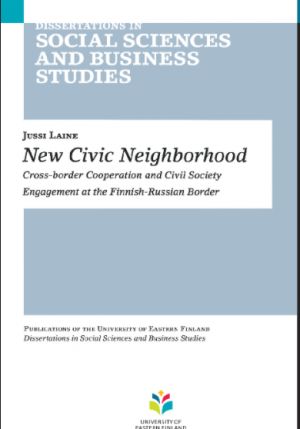This study examines the actual and potential role of Finnish civil society organizations in developing new forms of cross-border cooperation with Russia.It puts forth the concept of civic neighborhood as a bottom-up alternative to the
official notion of 'European' Neighborhood. As the period to be analyzed begins
with the collapse of the Soviet Union, it covers the era during which Finnish-Russian bilateral relations became a part of broader EU-Russia relations. The formation of civic neighborhood is studied on the basis of two major empirical primary datasets, of which one consists of interviews and another one of published newspaper materials. The two datasets provide different, yet mutually complementary perspectives on the phenomenon under study. It is vital to study both perspectives as perceptions, since images of the other and discursive relations are not mere results of cooperation practices but also
and more importantly their prerequisites.The optimal way to normalize neighborly relations is to increase people-to-people interaction, and preferably this ought to occur from the bottom up rather than the top down. While state institutions and structures may contribute to the shaping of the general operational environment, the maintenance of civil society cooperation cannot be expected to rest entirely on the state. In light of the current trends that reduce the funds allotted for cross-border cooperation on the one hand, and the decentralization and privatization of public services on the other hand, it would be fruitful to conceptualize a cross-border space for social contracting and entrepreneurship through civil society organizations. This would allow the civil society organizations to gain further leverage to fill in the gaps created by borders and bordering, and to bridge the apparent intersectoral crevasses.Keywords: civil society, neighborhood, cross-border cooperation
This study examines the actual and potential role of Finnish civil society organizations in developing new forms of cross-border cooperation with Russia.It puts forth the concept of civic neighborhood as a bottom-up alternative to the
official notion of 'European' Neighborhood. As the period to be analyzed begins
with the collapse of the Soviet Union, it covers the era during which Finnish-Russian bilateral relations became a part of broader EU-Russia relations. The formation of civic neighborhood is studied on the basis of two major empirical primary datasets, of which one consists of interviews and another one of published newspaper materials. The two datasets provide different, yet mutually complementary perspectives on the phenomenon under study. It is vital to study both perspectives as perceptions, since images of the other and discursive relations are not mere results of cooperation practices but also
and more importantly their prerequisites.The optimal way to normalize neighborly relations is to increase people-to-people interaction, and preferably this ought to occur from the bottom up rather than the top down. While state institutions and structures may contribute to the shaping of the general operational environment, the maintenance of civil society cooperation cannot be expected to rest entirely on the state. In light of the current trends that reduce the funds allotted for cross-border cooperation on the one hand, and the decentralization and privatization of public services on the other hand, it would be fruitful to conceptualize a cross-border space for social contracting and entrepreneurship through civil society organizations. This would allow the civil society organizations to gain further leverage to fill in the gaps created by borders and bordering, and to bridge the apparent intersectoral crevasses.Keywords: civil society, neighborhood, cross-border cooperation













